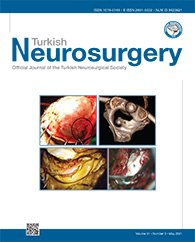2Hakodate Shintoshi Hospital, Department of Neurosurgery, Hokkaido, Japan DOI : 10.5137/1019-5149.JTN.31089-20.2 AIM: To compare the low-profile visualized intraluminal support (LVIS or LVIS Jr.) stent, which is a braided microstent, and Enterprise Vascular Reconstructive Device (VRD), which is fabricated using laser cutting technology, in the treatment of internal carotid artery aneurysms.
MATERIAL and METHODS: We investigated 49 unruptured aneurysm cases in which follow-up digital subtraction angiography had been performed. Results of the occlusion were divided into classes 1, 2, and 3 of the Raymond-Roy Occlusion Classification. Statistical significance was defined as p<0.05.
RESULTS: In the 49 aneurysm cases, we achieved class 1 in 23 (47%; LVIS or LVIS Jr., 7; Enterprise, 16; p=0.76), class 2 in 13 (27%; LVIS or LVIS Jr., 5; Enterprise, 8; p=0.74), and class 3 in 13 (27%; LVIS or LVIS Jr., 5; Enterprise, 8; p=0.74). Based on the follow-up imaging of the 49 aneurysms, we achieved class 1 in 32 cases (65%; LVIS or LVIS Jr., 16; Enterprise, 16; p<0.01), class 2 in 7 (14%; LVIS or LVIS Jr., 0; Enterprise, 7; p<0.01), and class 3 in 10 (20%; LVIS or LVIS Jr., 1; Enterprise, 9; p=0.13).
CONCLUSION: Recently, the flow diversion effect of stents has garnered more attention compared to coil embolization. LVIS or LVIS Jr. exerts a higher flow diversion effect than other stents and may improve the Raymond-Roy Occlusion Classification. In the future, the role of stents in the treatment of aneurysms will become more important.
Keywords : Stent-assisted coiling, Low-profile visualized intraluminal support, Enterprise VRD, Internal carotid artery aneurysms




